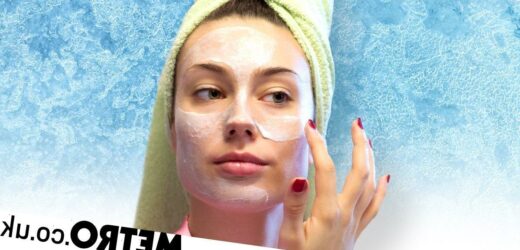We all have different skin, which means we all need slightly different things from our skincare – particularly in winter.
The cold temperatures, harsh weather conditions, and increased exposure to central heating in the winter months can leave our skin dry, irritated, or just generally more prone to flare-ups.
‘In the winter, it’s important to work hard at keeping the skin well moisturised,’ says skincare expert Dr Deborah Lee.
‘Ceramides and hyaluronic acid are great skin moisturisers and help keep moisture trapped in the skin. You may want to apply a serum to the skin and leave it for five minutes to soak in, before adding a moisturising cream as an additional layer.
‘Also, use skin products containing high levels of antioxidants such as vitamin C and glutathione. These will help brighten the skin and help the skin to glow. Remember to keep using sunscreen with an SPF 30 rating, even in the winter.’
As skincare improves and caters to a wider range of needs, it can also feel a bit overwhelming.
It feels like every week there is a new ‘must-have’ skin product that is going to work miracles. It can be hard to keep up, or understand what will work best for your skin.
Thankfully, the beauty experts at Vice Reversa have shared the best skincare active ingredients to use for your skin type, as well as the ones to avoid using.
Here, Dr Lee explains which labels you need to look out for this winter if you’re investing in some new products:
AHA
‘AHAs are chemical exfoliators – these are acids that help you shed dead skin cells,’ says Dr Lee. ‘They are derived from fruit, are soluble in water, and are ideal to encourage the most superficial layers of skin to peel off. They are especially good for those with dry or sun-damaged skin.’
Dr Lee says they are suitable for most skin types, but take care if you have sensitive skin as they can occasionally cause dryness and irritation.
‘Ideally, use AHAs with hyaluronic acid and ceramides as these are excellent moisturisers and doing this helps prevent the skin from drying out.
‘AHAs should only be used once or twice a week. They can make the skin more sensitive to light, so are best used in the evening before bedtime.’
Beta-hydroxy acids (BHA)
BHAs are another group of skin exfoliating acids. Dr Lee says they help remove dead skin cells and brighten up dull-looking skin.
They are suitable for most skin types but, like with the AHAs, they can dry out sensitive skin.
‘The most common BHA used for the skin is salicylic acid (aspirin) and is often useful in treating acne,’ she adds. ‘Because it dissolves in oil, it is able to get deep inside the skin pores and helps unclog them, hence it helps treat acne lesions and remove blackheads. It may also be useful for those with rosacea.
‘BHAs and AHAs are often combined in one skin product to achieve the best exfoliation. BHAs are ideal for greasy or combination skin. They have an anti-inflammatory action, as well as reducing fine lines and wrinkles. They can also lower the photo-ageing of the skin.’
Dr Lee says you should only use BHAs in the evening, before bedtime, as they increase skin sensitivity to sunlight.
‘Ideally, use BHAs with hyaluronic acid and/or ceramides as these are excellent moisturisers and this will help prevent the skin from drying out. BHAs should only be used once or twice a week.’
Dr Lee says neither BHAs or AHAs should be used with retinol.
Ceramides
‘These are naturally occurring lipids (fats) that are present in the skin,’ says Dr Lee. ‘They function as a type of skin cement, to hold the skin cells together, creating a barrier that protects the skin from harm and traps water, preventing the skin from becoming dehydrated.’
According to Dr Lee, ceramides are important in helping to prevent ageing of the skin and keeping the skin looking youthful and supple.
‘They are suitable for all skin types and can be used with AHA and BHA,’ she adds. ‘They can be used with retinol, to improve skin tone and elasticity.
‘They are also suitable for use with niacinamide which is another powerful ingredient that helps restore the barrier function of the skin. They should be used twice a day.’
Hyaluronic acid (HA)
Dr Lee explains that HA is the major component of the skin’s ‘extracellular matrix’.
‘It plays a vital role, holding the skin cells together to form a protective layer, keeping invading organisms out, while keeping water trapped underneath,’ she adds.
‘HA is suitable for all skin types. It is especially useful in ageing skin, as ageing is associated with a loss of moisture from the skin, and it tends to become dry.
Although HA is safe for all skin types, it can occasionally cause irritation to sensitive skin, probably because it speeds up absorption of other skin products.’
The good news is that HA can be used with retinol, which also has anti-ageing properties, including stimulating the production of collagen.
‘Retinol tends to improve skin texture and helps smooth out fine lines and wrinkles,’ she says. ‘It also thickens the skin by stimulating the production of glycosaminoglycans. Retinol also has positive benefits for acne.’
Niacinamide
Niacinamide – otherwise known as vitamin B3 – is commonly found in skin products. Dr Lee says it’s known to help shrink large pores, improve dull skin tone, and soften fine lines and wrinkles.
‘It also helps improve the defense barrier of the skin and also maximises hydration,’ she adds. ‘It is suitable for all skin types.
‘Retinol, peptides, HA, BHAs and AHAs, and vitamin C can all be used with niacinamide. Topical niacinamide may even stimulate natural skin production of ceramides.’
Dr Lee says niacinamide mixed with vitamin C is a good combination for reducing or eliminating pigmentation such as age spots.
‘Always use a good SPF factor 30 sunscreen if you are using niacinamide to try and reduce pigmentation, as sunlight will counteract its effects. The same applies to tranexamic acid.’
Peptides
‘Peptides are small chains of amino acids – proteins – which are small enough to be absorbed through the skin surface,’ says Dr Lee.
‘Collagen, for example, consists of three peptides. The collagen molecule itself is too large to pass into the skin, but the smaller peptides, once they have entered the skin cells, can join up to form new strands of collagen.’
Peptides help the barrier function of the skin, Dr Lee says they also help in skin repair and protection – helping prevent skin damage from toxins such as air pollution or cigarette smoke.
‘Some peptides have antimicrobial properties so can help reduce inflammation in acne,’ she adds. ‘All skin types can safely use peptides. These are commonly mixed with retinol, niacinamide, ceramides, vitamin C and hyaluronic acid.’
Tranexamic acid (TA)
The good news is that TA can be used by all skin types.
‘It is often recommended to treat hyperpigmentation of the skin, for example, in melasma, excess skin pigmentation that occurs in pregnancy,’ says Dr Lee. ‘It inhibits the action of the enzyme tyrosinase and hence prevents the production of the skin pigment, melanin.
‘It is also useful in the treatment of acne rosacea, as it stimulates the local immune response and reduces angiogenesis (new blood vessel formation). In rosacea, the use of TA on the skin can reduce flushing, itching, and burning.’
As retinol and tranexamic acid are both acids, Dr Lee says it’s not advisable to mix them as this can be very drying for the skin, and also increase the risk of U/V sun damage.
Retinol
‘Retinol is a vitamin A derivative with powerful properties,’ says Dr Lee. ‘It stimulates the production of elastin and collagen and enhances skin cell turnover. It improves skin tone, brightens the skin, and helps minimise fine lines and wrinkles. It is often used for its anti-ageing properties.’
It’s also well known that retinol increases skin sensitivity, including increased sensitivity to UV light, so it should only be used at night.
‘Although retinol is generally suited to most skin types, it should be used with caution in those with sensitive skin,’ she says.
‘One rule in dermatology is never to mix skin acids, such as AHA and BHA, with retinol – as these also increase skin sensitivity.
‘Don’t mix Retinol with Vitamin C, as retinol is very drying for the skin. Retinol is good for skin repair and should be used at night, whereas vitamin C protects the skin from pollutants, and is best used in the mornings.’
Vitamin C
Vitamin C isn’t just for fighting off winter colds, it’s also a powerhouse for your skin. The good news is that this active ingredient is suitable for use on all different skin types.
‘Vitamin C is a powerful antioxidant, helping to counteract skin damage from oxidative stress,’ says Dr Lee. ‘This means it helps protect the skin from everyday ‘wear and tear’ damage, and also from UV light.
‘It has important anti-ageing functions in the skin, and helps brighten a dull skin tone, even out rough areas of skin, and can help smooth fine lines and wrinkles. It also helps fade dark skin spots. Vitamin C is a common ingredient in skin products and can be used on all skin types.’
Dr Lee recommends mixing Vitamin C with hyaluronic acid as these two ingredients work very well together.
‘Vitamin C can also be used in conjunction with glutathione to work well together as both substances work to reduce hyperpigmentation,’ she adds.
‘Vitamin C should not be used with retinol, or with AHA or BHA acids.’
Do you have a story to share?
Get in touch by emailing [email protected].
Source: Read Full Article



